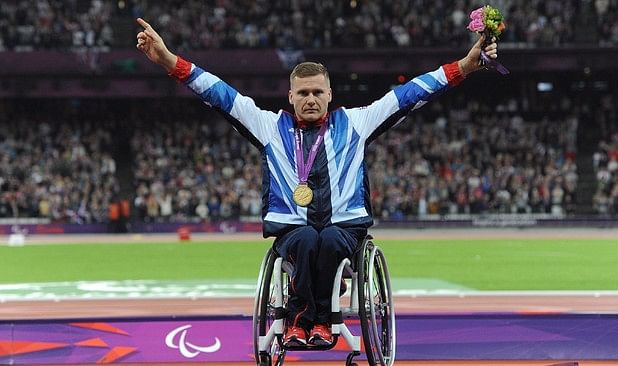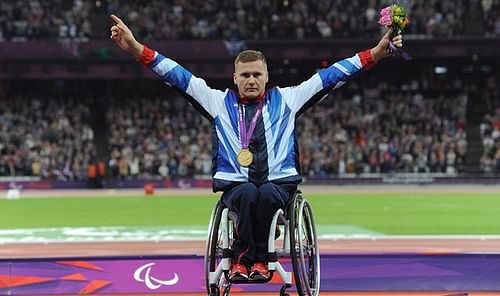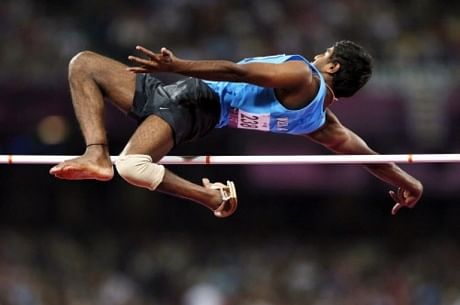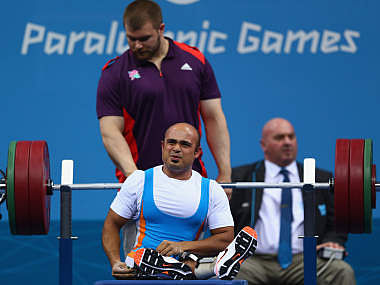
What didn’t kill them, only made them stronger!
165 nations, over 4,200 athletes, 20 sports, 70,000 volunteers, more than 2.6 million tickets sold – the 2012 Paralympics in London were not just the most successful Paralympics ever, but one which will inspire a generation in the years to come.

When a congenital spinal cord trans-section – a condition of severing of spinal cord – meant that David Weir of England could never use his legs, Weir, a talented youngster from London, made sure he didn’t let his disability hinder his dreams. His propensity for athletics and never-say-die spirit made him take up wheelchair racing as a profession and by the time he ended up taking part in the 2012 Paralympics, he had six Paralympic golds (four of which came in London) and the tag of the greatest wheelchair athlete of Britain by BBC, even putting him at par with other British Olympic stalwarts like Jessica Ennis and Sir Chris Hoy.
David Weir’s story of a Paralympian’s triumph over adversities is just one of the many that were on display at the London Paralympics this year. Each athlete at the Paralympics, with his or her unique tale, redefined the word ‘courage’ and made the London games a spectacle to remember.
One man who was the cynosure of everyone’s eye at this summer’s dual games was the famous “Blade Runner” from South Africa – Oscar Pistorius. Pistorius was born with fibular hemimelia - congenital absence of the fibula – and therefore had both his legs amputated between his knees and ankles when he was 11 months old. In August this year, Pistorius became the first double leg amputee to participate along with the ‘able-bodied’ athletes when he took part in the London Olympics. He certainly did make his presence felt at the games, when he reached the semi-final of the men’s 400 metres race, becoming the first man to do so in the 116 year history of the modern Olympics.
But not all competing athletes at the 2012 Paralympics were born with disabilities. While some did grow up with disabilities, others were victims of wars and accidents. Malek Mohammed, a double amputee swimmer from Afghanistan, stepped on a landmine and severed both his legs when he was just 11 years old. Then there was Martine Wright, a British sitting volleyball player, also lost both her legs in the 7/7 London Bombings. While there were sufferers of explosions and bombings, others, just victims of freak accidents. South Africa’s swimmer Achmat Hassiem injured his right leg when he was attacked by a great white shark!
What is strikingly akin to all these athletes is that, each one of them found in sports a medium to rebuild their lives which consequently helped them overcome all those odds and stereotypes they faced during their struggles. Never once did they let the so called ‘health chauvinists’ stigmatize them in any which way.
But it isn’t just the remarkable rising-from-the-ashes tales of paralympians that made the London Paralympics such a fascinating event. What was also heartening to see was the wholehearted manner in which not only London, but the whole world accepted the games and turned up in full attendance for every event.
The mere fact that some 2.7 billion tickets were sold certainly showed that there was a definite surge in interest for the Paralympics. No wonder IPC president Philip Craven described it as the ‘Greatest Paralympic Games ever’ and one which has ‘changed us all forever.’
The Olympics might be the ultimate sporting spectacle on earth right now, but the Paralympics in London showed that the primo event of the disabled certainly isn’t far behind, and with the right attitude of the federations; it can become the next big thing in the international sporting calendar.
Girisha’s leap to glory

In a nation where Olympic sports aren’t given the first priority, leave aside Paralympics, it must have come as a huge surprise to most Indians when a little-known Girisha Hosanagara Nagarajegowda won the silver medal in the men’s high jump F-42 category at the London Paralympics.
The 24 year old son of a daily wage labourer, Girisha has impairment in his left leg, and had to take up paralympic sports as his parents could not afford his surgery. Considering the paucity of resources Girisha had, his performance was certainly a remarkable feat, and one, which made the Indian public stand up and take notice.
Girisha’s journey from despair to glory is an inspiration; an inspiration not only for the ‘differently-abled’ Indians to take up sports, but one, that should awaken the parochial Indian society from its potholes of shallow imaginations and hopefully sow new seeds of change towards a more brighter and liberated India.
And amidst the glory, there was agony!

He was contracted with Polio when he was just one. His wife had to sell all her jewellery to fund his trips to international events. He fought through tumultuous times and went onto become the best power lifter among the disabled in the country, bringing medals in various international events. Even after giving so much to country, when Farmaan Basha’s request to provide him an escort during the London Paralympics was rejected by the Paralympic Committee of India (PCI) so that the PCI members could be accommodated at the games, it once again posed serious questions marks on the federation’s willingness to boost the Paralympic sports in India.
What it showed is that despite living in an era of rampant modernization and technological advancement, the dreaded ghosts of nepotism and discrimination still exist in our society.
But all said and done, the Paralympics 2012 certainly did more good than harm for India. The television or media coverage it received might not have been the same as it was for the Olympics, but social platforms like Twitter and Facebook made sure the London Paralympics did not go unnoticed to an average Indian. The signs are encouraging, the curiosity is rising among the general public and come the 2016 Paralympics in Rio, we might see a lot more Indians rooting for real life heroes like Farmaan and Girisha.